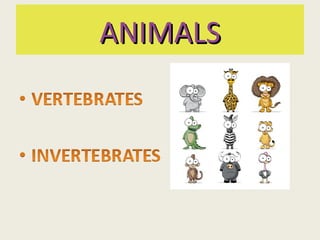
ANIMALS vertebrates and invertebrates
- 1. ANIMALS
- 2. LESSON PLANNING • TOPIC: ANIMALS, VERTEBRATES AND INVERTEBRATES • LEVEL: 3RD COURSE PRIMARY EDUCATION • TIME: 10 SESSIONS • DESCRIPTION OF LESSONS: - Animals - Vertebrates - Invertebrates
- 4. 2.Tadpole 3. They grow 1. Frog’s eggs legs 4. And finally!! The frog
- 5. Spinal column Skeleton
- 6. Fish live in water and breather through gills. Their skin is covered in scales and they have fins to swim.
- 7. 2.- AMPHIBIANS Amphibians can live in water and on land. Their babies live in the water and breathe through gills. The adults breathe through lungs and through their skin. Newt Frog
- 8. 3.- REPTILES A lot of reptiles live on land and some in water. They breath through lungs. Their skin is covered in scales and some have a shell. Snake Tortoise shell scales
- 9. 4.- BIRDS Birds live on land and in the air. They breath through lungs. They have feathers and wings. eagle feathers wings hummingbird
- 10. 5.- MAMMALS A lot live on land, some in water. They breathe through lungs. Their body is covered in skin and fur. Their babies feed on their mother’s milk. bears seals fur
- 11. (1) (3) (2)
- 12. c) How they reproduce: Most vertebrates are oviparous: their babies are born from eggs laid by the mother (fish, amphibians, reptiles and birds) turtles birds Some vertebrates, the mammals, are viviparous: their babies are born alive from their mother’s womb horses Human beings
- 13. Invertebrates are animals that do not have a spinal column or a skeleton made of bones. Some invertebrates are: jellyfish, worms, molluscs and arthropods jellyfish jellyfish snail worms arthropods molluscs earthworm
- 14. Most of the animals on The Earth are invertebrates, many of them live in the sea and are very small • They have a soft body because they do not have skeletons. • Many have a shell or exoskeleton to protect their soft bodies shell Soft body exoskeleton
- 15. a) What they eat: They are carnivores, herbivores and omnivores. b) How they breathe: Some breathe through their skin, others through gills, and others through lungs. c) How they reproduce: All invertebrates are oviparous. Their offspring are called larva. When they grow, some of them change shape.
- 16. 1.- What is a vertebrate? What type of vertebrate is a dog? ___________________________________________________ 2.- What are the five groups of vertebrates? ___________________________________________________ 3.- In what way can we classify vertebrates? ___________________________________________________ 4.- What is an invertebrate? ___________________________________________________ 5.- How do many invertebrates protect their soft bodies? ___________________________________________________ 6.- How do invertebrates reproduce? ___________________________________________________ 7.- In what way can we classify invertebrates? ___________________________________________________
- 18. Write two characteristics of the following animals ______________________________________________ ______________________________________________ ______________________________________________ ______________________________________________ ______________________________________________ ______________________________________________ ______________________________________________ ______________________________________________
- 19. Answer these questions This is an elephant, a mammal: How does it breathe? What does it eat? How does it reproduce?